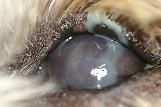What is Dry Eye?
Keratoconjunctivitis sicca (KCS), commonly referred to as “Dry Eye”, is one of the most common dog eye problems. Dry Eye affects 1 in every 22 dogs.
Dry Eye is caused by destruction of the tear glands by the dog’s immune system. This means that too few natural tears are produced. Damage to the tear glands is irreversible. If left untreated, eventually the tear glands are completely destroyed and the dog loses the ability to produce tears. Dry Eye is a painful condition, and ultimately leads to permanent blindness.
Both these dogs have Dry Eye – but look very different.
Natural tears have many important functions which are lost in Dry Eye: they carry vital nutrients and oxygen, lubricate and cleanse the eye, and help protect against infection. Without tears, the eye becomes very dry and uncomfortable. Conjunctivitis, eye infections and ulcers become more common and discharge may be seen from the eyes. New blood vessels start to grow on the surface of the eye and dark pigmentation may develop. Eventually these changes lead to permanent blindness. It is very important to diagnose Dry Eye early, before these undesirable changes become severe and much of the tear tissue is destroyed.
It is important to recognize that in the vast majority of cases, Dry Eye is a lifelong condition and requires lifelong treatment. If not treated correctly, the dog will experience discomfort and the disease will affect its sight and welfare long term.
Dry Eye has a very variable appearance, so it is not possible to diagnose the condition just by looking at it. Fortunately there is a quick and simple test to diagnose Dry Eye, and with correct treatment the condition can be managed successfully long term.
Dry eye can affect all breeds at any age, so it is important to be aware of the signs to look out for.



